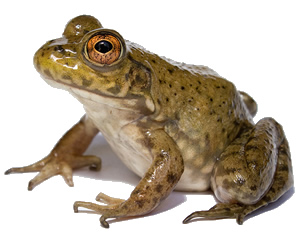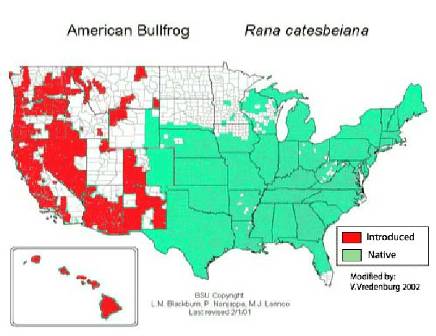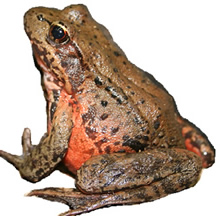Case Study - Are Invading Bullfrogs Harmful?
 Part 1: What's in the Pond?
Part 1: What's in the Pond?
Laura scooped a water sample from a pond near Clear Lake in California. The sample contained several larval forms of insects and a few tadpoles. She'd been studying under Professor Clark all semester, studying invasive species in water reservoirs. She no longer needed a field guide to identify the tadpoles in her sample as Rana catesbeiana, or the American bullfrog. She cataloged the tadpoles from the sample and identified mosquito and damselfly larvae. Her lab notebook contained data from the last three weeks where she'd also identified crayfish, trout, bluegill, catfish, leopard frogs, red-eared sliders, and water snakes.
Professor Clark joined her a few minutes later carrying a large bullfrog he'd fished up from the pond. "Check this guy out!"
Laura jumped up to view the specimen, she'd seen plenty of small frogs and tadpoles, but the bullfrog in Professor Clark's hand was the biggest amphibian she had ever seen, easily weighing a pound. Professor Clark used his pen to point out the dorsolateral ridges that for bullfrogs extend around the tympanic membrane instead of going in a straight line down the frog's back. "This one is a female, notice how her eardrum is about the same size as her eyes."
Professor Clark released the frog back into the pond with a heavy sigh. "There's no way we are going to be able to stop them now."
"How do you think they got here in the first place?"
"Unfortunately, bullfrogs were brought to California in the early 1900's, some of them were brought as food sources, some were introduced as pets and even some were deliberately added to ponds to control the mosquito population. At the time, they had no idea what the bullfrogs would do to the native populations."
Laura returned to the cabin where her and the other grad students were staying while they collected data. As the sun was going down she could hear the familiar call of bullfrogs from the nearby pond and lake.
Questions:
1. The map shows the native range of the bullfrog and the areas where the bullfrog has been introduced. Are there any natural barriers between the east side of the map and the west side? If humans had not introduced the frog, do you think the frog would have naturally expanded its range?

2. Hawaii has not recorded any bullfrog sightings. What policies or laws could you keep in place to prevent the bullfrog from invading Hawaii?
3. Use google to search from an image of a bullfrog. One unique feature is the dorsolateral ridges. Sketch the frog showing how these ridges are different in the bullfrog.
4. Based on Laura's sample of pond water, you can make inferences about the composition of the community. Which inhabitant of the community is most likely to be impacted the most by a bullfrog invasion? Defend your choice.
5. Watch this video from StatesmanJournal.com showing how to identify bullfrogs. Describe the bullfrog's NICHE. A niche refers to an animal's habitat and way of life (what it eats, how it mates, how it builds a nest ...etc) Alternately, you can read the article from the same organization at: biol.co/bullfroog Why do you think ecologists suggest that controlling the species is more valid than elimination?
Part 2: The Research Facility
The next day, Laura went to the facility nearby where the bullfrogs were being studied in the lab. Scientists have been looking for ways to control the population without adversely affecting native species. One artificial pond of interest contained largemouth bass. While the bass are also not a native species to California, in places where they do live, they have been known to eat bullfrog tadpoles and even juveniles. Other fish seem to not like the taste of bullfrogs. The pond at the facility was full of American bullfrogs and large mouthed bass, interns were carefully collecting data on how the two species interacted.
Laura sat down at her desk to input the data from the last week. An email from Professor Clark popped up.
"Hey, we just got data from the facility in Arizona where they introduced large mouth bass into a lake 12 years ago. I've attached the file. We need a graph of this for our report.
Laura paused to access the file which appeared to be a table showing the numbers of bullfrog and bass from data gathered at the lake.
| Year | Number of Bullfrogs (estimate) | Number of Bass (estimate) |
| 1 | 80,000 | 1,000 |
| 2 | 60,000 | 8,000 |
| 3 | 40,000 | 12,000 |
| 4 | 10,000 | 28,000 |
| 5 | 8,000 | 10,000 |
| 6 | 22,000 | 14,000 |
| 7 | 32,000 | 16,000 |
| 8 | 41,000 | 18,000 |
| 9 | 11,000 | 29,000 |
| 10 | 22,000 | 9,000 |
| 11 | 28,000 | 13,000 |
| 12 | 35,000 | 18,000 |
6. The data shows the relationship between a predator and a prey, commonly called a predator-prey graph. Create a graph that shows two lines, one for the bass and one for the bullfrog. Time should be on the x axis, and number of individuals on the Y axis. You may attach graph paper provided by your instructor or use an online tool to create and share your graph - http://biol.co/gra3ph.
7. Based on the data shown, would you recommend that bass are an effective way to control bullfrog populations? Why or why not?
Part 3: How can the Frogs be Controlled?
Also at the research facility, biologists were studying the effects of toxins on the frog populations as they looked for a way to control them using chemicals. Professor Roberts, who also worked on this problem had begun writing his thesis on chemical control of frog populations. His rough draft was on the bulletin board where the other scientists and undergrads could read it and comment. Laura took a moment to read Professor Roberts findings.
Toxicants have potential to help in the control bullfrogs, but broadcasting toxicants in aquatic systems can be dangerous to non-target species that may be found there. We examined the efficacy of various compounds that were originally tested for controlling invasive Coqui frogs (Eleutheradactylus coqui) in Hawaii.
In a laboratory trial, we sprayed about 4 ml of treatment solution on the entire dorsal surface of randomly-selected groups of bullfrogs, using a hand-held plastic spray bottle. Water was used as the solvent for all materials. To improve solubility, a small amount of sodium benzoate was added to the caffeine solution and a small amount of alcohol was added to chloroxylenol solution. We found 3 potential toxicants for controlling bullfrogs (Table 1). These compounds should undergo stringent testing to examine for any effects that could occur on non-target species, prior to any use in the field. Also, an effective delivery system for these compounds is necessary (e.g., local spraying versus wide broadcasting).
Laura shook her head after reading the section of the report. . Though she understood that the bullfrogs were invasive species that harmed native wildlife, she had trouble with research that involved purposefully killing the frogs. Luckily, Professor Clark did not require her to participate in this part of the research.
In addition to the toxicant experiments, Professor Roberts was also exploring ways to trap the frogs, based on experiments done in Australia to control the Cane toad. The research report also included data on bullfrogs that were trapped from the north side of Clear Lake (table 2).

8. Based on the data in Professor Roberts report, what three toxicants would be most effective for controlling bullfrog populations?
9. What is meant by this statement in the report: "These compounds should undergo stringent testing to examine for any effects that could occur on non-target species"?
10. Why would Laura not want to work as Professor Roberts' assistant? How does your group feel about his experiments?
11. Based on the trapping data, can trapping be used to control bullfrog populations? How did you come to this conclusion?

Part 4: What about the native frogs?
Laura was just about to pack up and head home when she received another email from Professor Clark.
"Hey, I just got back from a town meeting and it doesn't seem like the parks commission is really on board with controlling the frogs at all. They don't see that its a problem to just leave things alone. The same thing happened up north, where the council decided to just let the frogs be and see what happened. Another university has been studying a group of ponds where frogs are raised together and separately to determine the impact. The ponds are up near Lake Placid. Can you call the university get their population counts for American bullfrogs and the native Rana draytonii - that's the California Red-legged Frog and the Northern Pacific Treefrog- Pseudacris regilla. We need to make an impact statement about what will happen if both the frogs live in the same environment.
Laura sighed and got to work, an hour later she received a fax from the university that provided populations estimates for species from data gathered over a 6 year period in their experimental ponds.
| Year 1 | Year 2 | Year 3 | Year 4 | Year 5 | Year 6 | |
| Rana draytonii alone | 500 | 690 | 800 | 840 | 850 | 900 |
| Pseudacris regilla alone | 500 | 780 | 900 | 1200 | 1300 | 1300 |
| Pseudacris regilla (with Rana catesbeiana) | 500 | 660 | 800 | 1100 | 1200 | 1200 |
| Rana draytonii (with Rana catesbeiana) | 500 | 580 | 500 | 400 | 350 | 200 |
As Laura considered the data, she was reminded of her basic ecology class and learning about how an introduced species can impact local populations. In ecology, the competitive exclusion principle, sometimes referred to as Gause's law, is a proposition that states that two species competing for the same resource cannot coexist at constant population values. When one species has even the slightest advantage or edge over another then the one with the advantage will dominate in the long term. One of the two competitors will always overcome the other, leading to either the extinction of this competitor or an evolutionary or behavioral shift toward a different ecological niche. In other words, no two species can occupy the same niche.
12. Create a graph that shows the populations numbers for years 1 through 6. Use a different colored line for each population so that they can easily be compared. You may attach graph paper provided by your instructor or use an online tool to create and share your graph - http://biol.co/gra3ph
13. Based on the data (and your graph), which of the native species will be least impacted by the introduction of bullfrogs?
14. A niche is loosely defined as an organism's role in its environment, which can include factors like, feeding preference, nesting behaviors, mating behaviors, method of obtaining prey, and local habitats. Considering Gause's law, conduct research on the California Red Legged Frog and the Northern Pacific TreeFrog (use wiki or other google search). Create a chart that compares the two with regard to their niche or their lifestyle that may explain how these two frogs can coexist in the same ecosystem.
15. Now consider how the addition of the bullfrog may affect these two native species in different ways. Why might one native species be more resilient than the other?
Part 5: What Are Your Recommendations?
Professor Clark entered the lab the next day, Laura had barely slept all night as she compiled the data and created charts. "Well, Laura, our time is up. The Parks Committee wants our recommendation tonight for the board meeting."
Laura laughed nervously. "And I thought I was going to be able to take a nap today."
The professor shuffled some of the piles of paper that were strewn across Laura's desk. "No such luck. You've been working hard on this project. Why don't you get me a rough draft of the letter we should compose to to the committee."
Laura was stunned, she was just an intern after all. "You want me to write the letter?"
Professor Clark smiled and grabbed his hat. "Yup, I think you know what we should do. I'm going fishing." With that, the professor walked out the door.
16. Write a letter to the Parks Committee that outlines your position on what to do about the bullfrogs. You have several options, including one that suggests not to do anything at all. No matter what you choose, in your writing be sure to:
- identify your position and recommendations to the committee
- explain WHY you would choose this course of action
- include specific details and evidence from your research (in this case study)
- use vocabulary that is appropriate and effective
- organize your thoughts into complete sentences and paragraphs
Bullfrog Photo by Brian Gratwicke, Flickr
Northern Red-Legged Frog by Tom Brandt, Flickr
The case study is fictional, though references real studies and information about bullfrogs.
Sources: http://www.columbia.edu/itc/cerc/danoff-burg/invasion_bio/inv_spp_summ/Rana_catesbeiana.htm
http://news.nationalgeographic.com/news/2004/09/0928_040928_bullfrog_2.html

